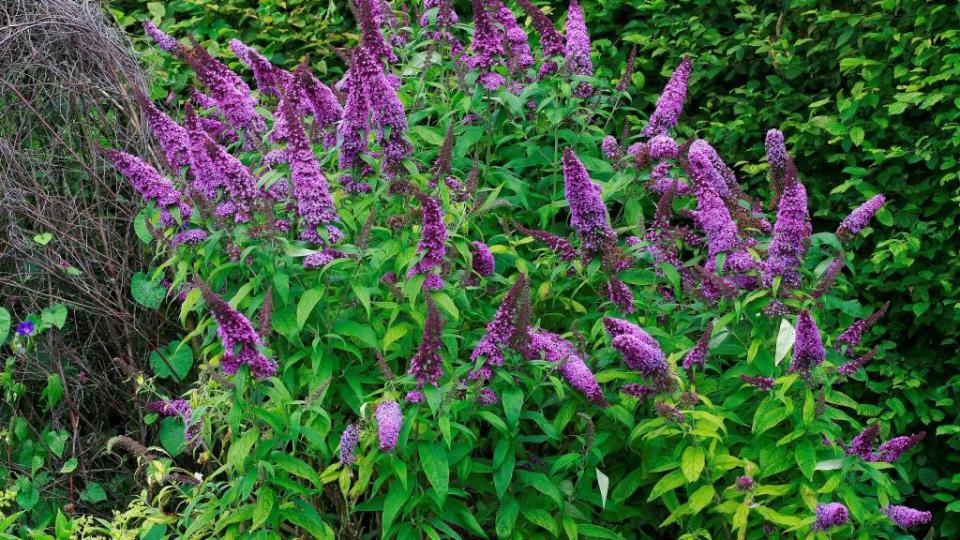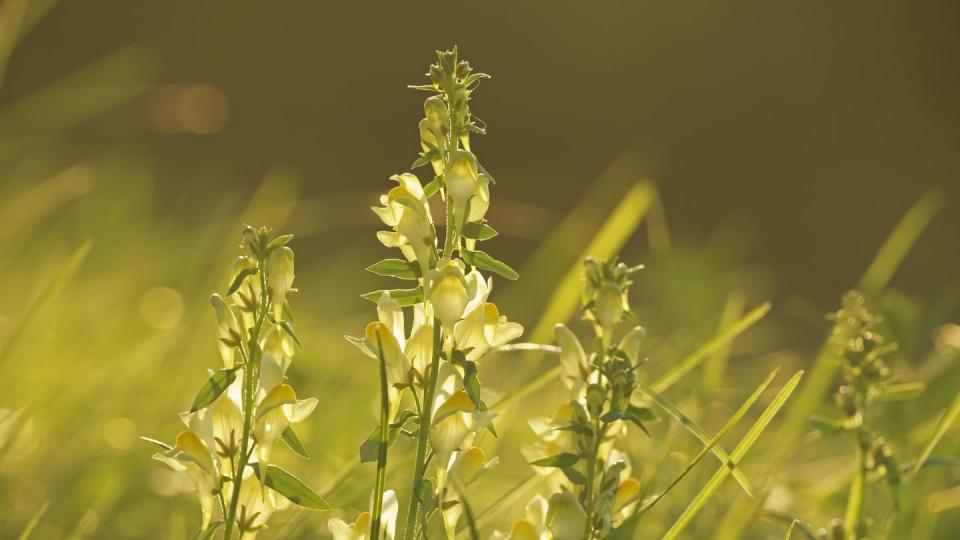These Deceivingly Pretty Invasive Plants Are Threatening Your Garden

"Hearst Magazines and Yahoo may earn commission or revenue on some items through these links."
Anyone who has dabbled in gardening understands the frustration of managing relentless weeds—but that occasional clover in your flowerbed is just the tip of the iceberg when it comes to invasive plants in the United States. In fact, the U.S. Department of Agriculture (USDA)’s official roster names hundreds of vines, shrubs, and flowers that pose danger to the ecosystems they’ve overtaken. And although you and your trowel may be outnumbered in that regard, it’s good to at least be aware of the most common invasive plants.
Meet the Expert: Rebecca Sears, chief marketing officer and resident green thumb at Ferry-Morse.
First, though, let’s start by understanding exactly what makes a species invasive.
What is an invasive plant?
“Invasive plants are non-native varieties that spread quickly and sometimes overtake native plants,” explains Rebecca Sears, chief marketing officer and resident green thumb at Ferry-Morse, a seed company. The U.S. Forest Service (USFS) expands there, adding that invasive plants are, by definition, likely to cause economic or environmental harm or harm to human health.
A caveat: Sears explains that invasive plants change with location. “Many gardeners often confuse invasive plants with aggressive plants that spread quickly,” she says, but the two aren’t always mutually exclusive. “Aggressive plants may have fast-spreading abilities, but are still native to the area they are spreading in,” she explains. “What is native in one area may be invasive in another (and vice-versa), so check with your local cooperative extension office to determine what plants are invasive in your area.”
What are the impacts of invasive plants?
Invasive plants “compete with native plants for necessities such as water, light, nutrients and space,” explains Sears. “As invasive plants continue to expand, they push out native plants and can ultimately eliminate their growth all together. Once invasive plants have a hold on your garden, they can also be extremely difficult to remove, as they often have deep root systems and produce a large number of seeds, allowing them to dominate.”
The USFS adds that invasive plants have contributed to the decline of 42% of U.S. endangered and threatened species. They also threaten plant diversity, which has a slippery slope effect on agriculture, water quality, recreation, and wildlife habitats.
Invasive plants
Again, the list of U.S. invasive plants is extensive—but these are a few common varieties to look out for.
Barberry (Berberis vulgaris, Berberis thunbergii)
“Barberry is one of the most common shrubs found in many parts of the U.S., introduced to the area originally as an ornamental plant that has now expanded and become extremely invasive,” says Sears. “Barberry is also harmful beyond its invasiveness, as it serves as a harbor for deer ticks.” According to the USDA, the bush is native of Japan, and also poses a threat by crowding out other trees.
Purple Loosestrife (Lythrum salicaria)

Purple loosestrife is a violet-colored flowering plant that is present in all 50 states in the U.S. It has the ability to produce as many as two million seeds in a growing season, which helps it overtake ecosystems, limiting biodiversity that largely affects birds in the form of reduced nesting sites, shelter, and food, according to Canada’s Invasive Species Centre.
Chinese wisteria (Wisteria sinensis)
“Though often complimented for the beautiful purple hues of its flowers, wisteria is actually an extremely invasive species that has the ability to smother and choke out native vines and trees by tightly wrapping around them,” says Sears. They also can live 50 to 100 years.
Butterfly bush (Buddleja davidii)

The butterfly bush is another common shrub native to China that is “often planted with good intentions,” says Sears. “It’s known for its popularity with butterflies as a source of nectar, but it is not a larval host for North American butterflies. Once planted, it produces an abundance of seeds and begins to spread like wildfire, often eliminating the plants that native butterfly caterpillars need.” The plant has been officially named invasive in several states including Washington, Pennsylvania, Oregon, and Maryland.
Exotic shrub honeysuckle (Lonicera species and cultivars)
Native to Asia and Southern Russia, honeysuckle bushes were introduced in the U.S. as an ornamental plant in the mid 18th and 19th centuries, per the USDA. Now, they pose a threat to native plants by shading them out for optimal growth, displacing native vegetation, and competing with other plants for pollinators, reducing the natural spread of seeds. The bushes produce flowers with white, pink, or red flowers.
Yellow toadflax (Linaria vulgaris)

Yellow toadflax is a bright, tall flower that was introduced from the Mediterannean region for medicinal and decorative purposes, per the USDA. It can now typically be found on roadsides, grasslands, and in crop fields, mainly in the Southwest. Not only do they pose a threat by crowding out other species, but they are highly adaptable and resilient, making them especially difficult to eliminate.
English ivy (Hedera)
Although ivy may cover the historic homes of your dreams, its presence isn’t necessarily great for the vegetation around it. The vining plant was introduced from Europe in the 1870s and is wildly fast-growing, allowing is to not only occupy too much space but even spread into tree canopies, per the USDA.
Poison hemlock (Conium maculatum)

The name says it all. Poison hemlock is a toxic weed that has taken over U.S. national parks and gardens in recent years. It has fern-like leaves and small white flowers, and when consumed, is toxic (and sometimes fatal) to both humans and livestock by affecting the central nervous and reproductive systems. It was introduced as an ornamantel plant and is technically part of the carrot, celery, and parsnip family.
Norway maple (Acer platanoides)
Weeds and shrubs may first come to mind when you think of invasive plants, but trees can be invasive, too. The Norway maple is one example. Native to Europe and Asia, the trees are hardy and can tolerate a variety of soil conditions and temperatures. They can grow up to 60 feet tall, and their impressive canopies can provide too much shade, inhibiting the growth of grass and vegetation beneath them. They also produce a great amount of seeds, allowing them to easily spread.
Garlic mustard (Alliaria officinalis)
Once grown for food and medicinal purposes, garlic mustard is now considered invasive across the U.S. Its tiny white flowers were first discovered in the mid-1800s, and since then, it has shown its ability to crowd out other species. According to the USDA, the weed poses a particular threat to the rare West Virginia white butterfly.
Giant hogweed (Heracleum mantegazzianum)
With an ability to reach heights of 10 feet, this invasive plant lives up to its name. Its transparent size is a threat to biodiversity and space on its own, but it also presents the unique risk of causing skin reactions in humans. The sap of giant hogweed is phototoxic, meaning when exposed to light, it can cause severe burns.
Tree-of-Heaven (Ailanthus altissima)
This tree, native to China, is rapidly invading forests, per the USDA, and not only does it threaten the ecosystems by taking over the land, its roots also have the ability to cause damage to pavement and building foundations in urban areas.
Buckthorn (Rhamnus cathartica)
Haling from most of Europe and Western Asia, Buckthorn is invasive for its ability to grow quickly and create tall, dense thickets that overcrowd other plant species. It’s also a host for environmentally damaging fungi, and it pollinates easily because birds are attracted to its dark, round berries, which ultimately transplants their seeds.
What to do if you spot an invasive plant
“Invasive plants can be manually removed by cutting, pruning, digging or hoeing to remove entire root systems, though this process can be time consuming and care must be taken not to damage surrounding plants,” explains Sears. “Many gardeners often turn to a method that involves smothering or covering the invasive plants with a tarp that blocks sunlight, though this method takes longer to actually kill the plants. Regardless of how you choose to remove invasive plants, the most important steps come when disposing of them to ensure that all material is removed so that seeds are unable to spread, allowing the invasive plants to reestablish themselves elsewhere in your garden.”
When it comes to controlling invasive plants in the wild, according to the USFS, you can do your part by not picking invasive weeds and flowers and taking them home, staying away from weed-infested areas, and using weed-free feed for pack animals, if you own any.
You Might Also Like

